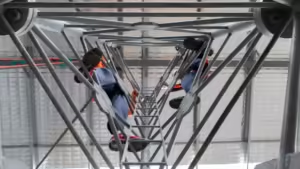Suspension trauma is the second biggest injury risk following a fall from height and can strike even if a safety system has worked as intended.
Falls from height, sadly, remain one of the biggest causes of injuries in the workplace. There are several reasons for this, ranging from the straightforward to the more obscure.
One often under-considered risk is that of suspension trauma. What makes suspension trauma dangerous is that it can occur even if a fall protection system has prevented a much worse accident.
Understanding what suspension trauma is and having tools available to mitigate it can help workers avoid this potentially fatal syndrome.
What is suspension trauma?
Suspension trauma goes by a couple of different names including suspension intolerance, harness hang syndrome, and suspension syndrome.
It occurs when a worker falls from height, and a fall arrest system limits the fall, but leaves the worker suspended in their harness, hanging off the ground.
A lack of movement of the legs can limit the ability of the circulatory system to return blood from the lower extremities to the heart. This leads to pooling of blood in those extremities and a reduction in the ability for the body to supply the brain with oxygenated blood.
The longer a worker is suspended like this, the greater the risk that worker can fall into unconsciousness or suffer from cardiac arrest (heart attack). When this occurs, the risks of the accident become fatal increases dramatically.
Suspension trauma can occur in as little as 10 minutes after a fall, according to the Australian Resuscitation Council. The exact time can be extremely variable, but it is best practice to ensure a suspended worker is recovered as quickly as possible.
Why suspension trauma is dangerous
What makes suspension trauma dangerous is that it can occur even if it appears as though a worker has not been obviously injured in a fall.
This can lead to responders assuming they have more time to put into effect rescue plans or, in the absence of an appropriate rescue plan, wait for the emergency services to arrive.
If a worker is left suspended for too long, suspension trauma can become fatal. Once consciousness is lost and the brain becomes increasingly deprived of oxygen, the greater chances of a poor outcome. It is vital that a worker be recovered as soon as possible after a fall, even if they appear uninjured.
How can suspension trauma be avoided?
There are a couple of ways that suspension trauma can be avoided.
The most practical is making sure that the workplace has an adequate emergency plan and rescue procedures in place. Co-workers should be properly trained and have the correct equipment available to implement the plan quickly in the event of a fall.
For a worker who has fallen and is suspended in their harness, the use of suspension trauma straps can assist in alleviating the pressure on the legs, improving blood circulation while they await rescue.
Should the worker not have trauma straps attached to their harness, they can tie a loop in their rope line and stand in that. This will allow them to generate movement of their legs, helping with blood circulation.
Ideally, methods should be used to complete work that mitigate the risk of a fall happening in the first place. Although in some high-risk environments this will not be possible. Completing work using a fall restraint system, rather than relying on fall arrest, may be one method available that can significantly reduce the chances of a fall occurring.
Get advice from experts
No matter your industry or workplace, Height Safety Engineers have the experience to assist in improving your safety. Our team can help you and your team put together a comprehensive emergency and rescue plan and supply the equipment and training you need to effectively implement it.
Call us on 1300 884 978 or email enquiries@heightsafety.net to start a safety journey with your partners in protecting people.





